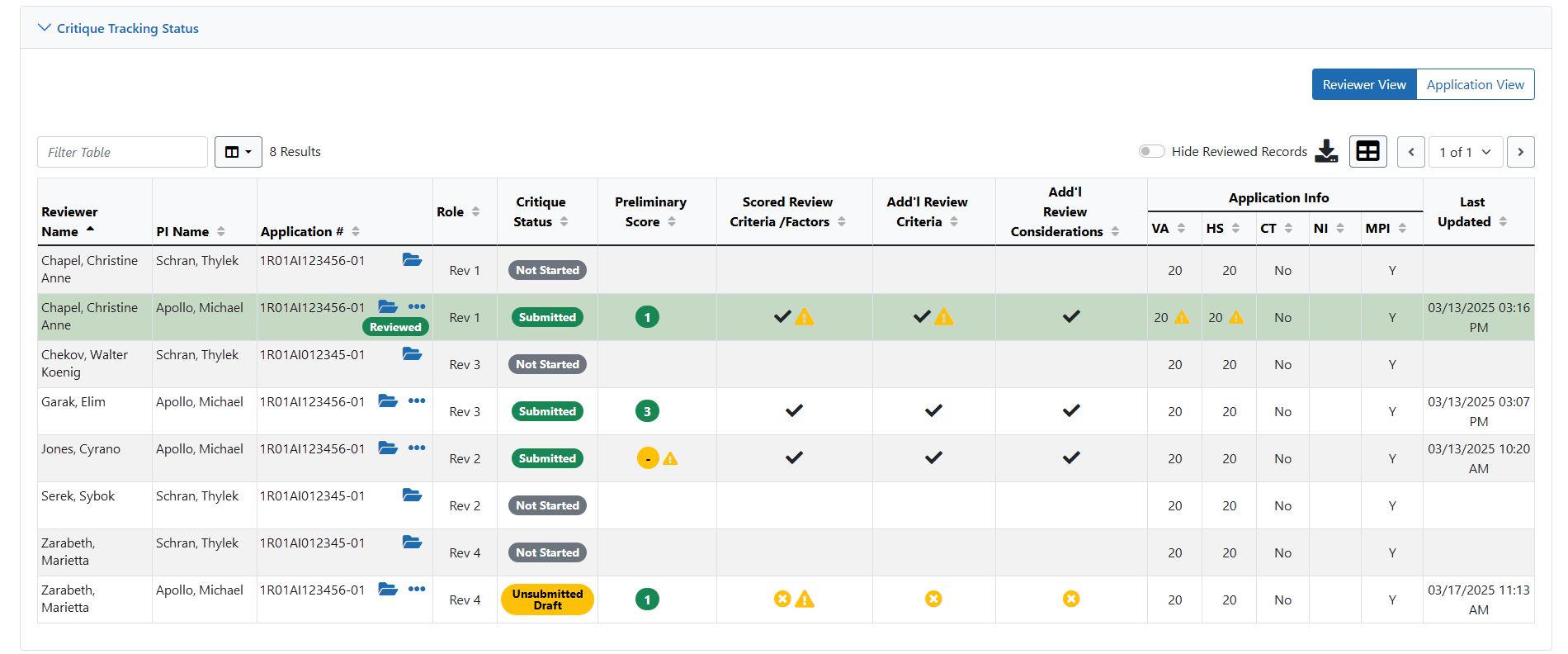Meeting Dashboard for OCT vs Non-OCT Applications
The Meeting Dashboard is not limited to online critique applications to provide at-a-glance status of application reviews for a meeting. The dashboard can be used to track the status of non-online critique applications, applications using word templates. However, because of the nature of the word templates, not all the same data is displayed in the dashboard.
General Information (OCT vs Non-OCT Applications)
The tiles in top section display different results based on whether the applications are OCT or non-OCT since some data from word-based critiques is not available to the dashboard.
 REVIEWERS WITH NO SUBMITTED CRITIQUES Tile
REVIEWERS WITH NO SUBMITTED CRITIQUES Tile
-
The circled number represents the number of reviewers who have not submitted any critiques for OCT and/or non-OCT applications for the meeting.
-
The number in the square represents all the assigned reviewers who are enabled in IAR for the meeting.
 CRITIQUES MISSING OVERALL IMPACT PARAGRAPH Tile
CRITIQUES MISSING OVERALL IMPACT PARAGRAPH Tile
-
The circled number represents the number of critiques for OCT applications only that do not have an overall impact paragraph.
-
The number in the square represents all the submitted critiques, both OCT and non-OCT applications.
 CRITIQUES WITH UNSUBMITTED DRAFT Tile
CRITIQUES WITH UNSUBMITTED DRAFT Tile
-
The circled number represents the number of critiques for OCT applications only that are in unsubmitted draft status.
-
The number in the square represents all the submitted critiques, both OCT and non-OCT applications.
 CRITIQUES MISSING SCORE Tile
CRITIQUES MISSING SCORE Tile
-
The circled number represents the number of critiques for OCT applications only that are missing scores. Missing scores can be the preliminary overall impact score, factor scores, and/or criterion scores.
-
The number in the square represents all the submitted critiques, both OCT and non-OCT applications.
Critique Submission Status (OCT vs Non-OCT Applications)
Meeting Phases Progression
There is no change in the ![]() Meeting Phases Progression. The blue chevrons indicate the meeting phase(s) that are currently active.
Meeting Phases Progression. The blue chevrons indicate the meeting phase(s) that are currently active.

Assignments Summary: Total, Completed, and Incomplete Assignments
![]() Assignment Summary consists of three sections: Total Assignments, Completed Assignments, and Incomplete Assignments.
Assignment Summary consists of three sections: Total Assignments, Completed Assignments, and Incomplete Assignments.
TOTAL ASSIGNMENTS. Total number of critiques assigned across all reviewers for both OCT and non-OCT applications. If you add all the numbers in the Total Assignments column, it adds up to this number.
COMPLETED ASSIGNMENTS. Total number of critiques, across all reviewers, that have been submitted for both OCT and non-OCT applications. The progress bar shows the number of completed assignments divided by the total assignments.
INCOMPLETE ASSIGNMENTS. The DRAFTS number indicates the scenario where a reviewer opened a critique and started editing it, but never submitted it for OCT applications only. The NOT STARTED number indicates the number of assignments where the reviewer has not entered any information into the critique whatsoever for both OCT and non-OCT applications.
Critique Submission Table
The following columns appear in the table on either the ![]() Reviewer View or
Reviewer View or ![]() Application View. The only difference is that in Reviewer View the numbers refer to the reviewer, and in Application View the numbers refer to the application.
Application View. The only difference is that in Reviewer View the numbers refer to the reviewer, and in Application View the numbers refer to the application.
Total Assignments. Shows the total number of critiques, OCT and non-OCT, assigned per reviewer (Reviewer View) or per application (Application View).
Submitted Critiques. Shows the total number of critiques, OCT and non-OCT, submitted per reviewer or per application.
Critiques with Unsubmitted Draft. This number indicates the number of OCT application only where a reviewer opened a critique, filled it out, submitted it, and later opened it again and edited it, but never re-submitted the new version.
Drafts. Indicates the number of critiques, OCT and non-OCT, per reviewer or per application in which the reviewer opened the critique, edited it, and did not submit it. This is different from the above count in that these drafts have never been submitted.
Not Started. Indicates the number of critiques, OCT and non-OCT, per reviewer or per application where the critique has not had any data entered whatsoever.
Submission Progress. For Reviewer View, this shows a percentage of critiques completed by a reviewer divided by the total number of critiques assigned to that reviewer for both OCT and non- OCT applications. For Application View, this shows a percentage of critiques completed for the given application divided by the total number of critiques assigned for that application for both OCT and non- OCT applications.
Critique Tracking Status (OCT vs Non-OCT Applications)
The ![]() Critique Tracking Status table functions nearly identically for both OCT and non-OCT applications, as described in Critique Tracking Status (Third Section) of the online help.
Critique Tracking Status table functions nearly identically for both OCT and non-OCT applications, as described in Critique Tracking Status (Third Section) of the online help.
The differences are:
The Preliminary Score column the Missing Overall Impact Paragraph indicator [ ] is displayed only for OCT applications.
] is displayed only for OCT applications.
Scored Review Criteria/Factor, Add'l Review Criteria, and Add'l Review Considerations columns are only shown for OCT applications. For non-OCT applications, the fields are blank.
Last Updated column is displayed only for OCT applications.
Hide Reviewed Records toggle switch function only for OCT applications.








